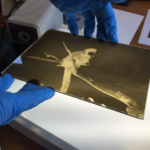As we mentioned back in December, the WCS Archives was recently awarded a major grant from the National Historical Publications and Records Commission to process several important collections. We’ve now started in on processing the collections, which in addition to the collections from Fairfield Osborn, Lee S. Crandall, and others that we mentioned in our initial announcement, also include records from James A. Oliver, New York Zoological Society press releases spanning most of the 20th Century, and several hundred illustrations from the Department of Tropical Research.
In order to complete the work, the Archives has brought on a full-time project archivist, Emma Curtis, to do the bulk of the processing. Each month Emma will be sharing her progress and latest discoveries in a post here on Wild Things. We’re as thrilled to have her with us as we are to be working on the grant!
These first few weeks have brought a few notable insights of New York Zoological Society’s rich history as progress begins to ramp up on tackling the thirteen previously unprocessed and under-processed collections selected from WCS Archives holdings for this project.


